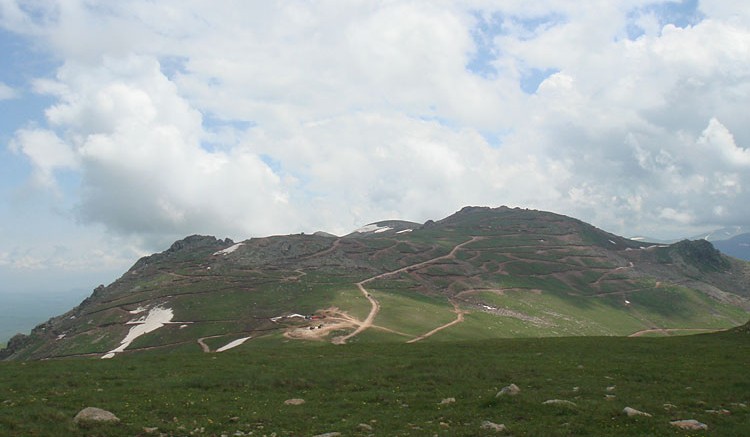VANCOUVER — Lydian International (LYD-T) is on the move in Armenia, as it advances its Amulsar gold project towards production.
In the last six months the company completed a feasibility study for the project, negotiated a new mining licence, finalized a new geological model, changed the mine development plan to incorporate new information from the model, planned a 40,000-metre drill campaign for 2013 and calculated a new resource estimate.
Now the resource estimate is out, and the company is increasing the contained gold at the project only slightly, while it boosts the average resource grade.
The near-surface, heap-leachable deposits at Amulsar contain 81.1 million measured-and-indicated tonnes grading 0.95 gram gold per tonne for 2.48 million oz. gold, plus 70.1 million inferred tonnes averaging 0.82 gram gold for an additional 1.85 million oz. gold. These numbers use a cut-off grade of 0.3 gram gold. Increasing the cut-off to 0.4 gram gold changes the measured-and-indicated count to 61.6 million tonnes grading 1.14 grams gold, and puts the inferred resource at 49.9 million tonnes averaging 1.02 grams gold.
The new estimate adds only a few hundred thousand ounces to the total contained gold count at Amulsar, but it increases the average gold grade by 16% in the measured-and-indicated categories, and by 11% in the inferred category, using 0.4-gram-gold cutoff numbers.
The grade improvements are made possible in part by the new 3-D geological model, which helps Lydian better understand Amulsar’s local lithology, alteration and structural controls.
There are four deposits at the project: Tigranes; Artavasdes and Arshak, which form a continuous northwest-striking zone of mineralization; and Erato sitting 1 km north. Mineralization remains open to the north, east and to depth at Erato, Tigranes and Artavasdes, while Arshak remains open along strike to the southeast.
Lydian plans to test the potential to grow Amulsar’s deposits laterally, but the more exciting direction for growth is at depth. The geological model suggests that barren rock previously thought to define the lower limit of mineralization could be, in many places, just a slice of the older, barren volcanic unit that is interwoven with the younger, gold-bearing volcanic unit at Amulsar. Recent drill holes extending through barren-rock slices have encountered mineralization below, which shows potential to expand mineralization at depth.
To test that theory, while also testing for lateral expansion and probing new induced polarization targets, Lydian plans to complete 40,000 metres of drilling at Amulsar in 2013. In 2012 the project saw only 20,000 metres of drilling, which brought total drilling at the site — since Lydian discovered gold there in 2006 — to almost 110,000 metres.
Drilling was somewhat limited last year because Lydian was focused on advancing Amulsar toward production, a push that produced a flurry of news.
In September Lydian announced the results of a feasibility study for Amulsar, which outlined a heap-leach mine producing 360,000 oz. gold annually for 12 years. The study estimated initial capital costs at just US$270 million and gave the project a pre-tax net present value of US$646 million and a 27.7% internal rate of return, using a 5% discount rate and a gold price of US$1,200 per oz.
Lydian later inked a mining licence deal with the Armenian government, which eased what had been a tight timeline to get into production by allowing for a four-year construction period. Under the old licence agreement, Lydian had to start producing gold by March 2015.
With its timing pressure eased, Lydian developed the new geological model and took a fresh look at its drilling and mapping data, realizing that it needed to change its mine plan.
The first problem was that the plan put the heap-leach pads on ground that has become prospective for more mineralization. Lydian plans to drill-test the area this year, but even if it is barren, the pads still need to be revamped because they are too small. With limited expansion capacity, the pads as designed would limit Lydian’s ability to extend the mine life where it found extra ore. Now Lydian is seeking a new location for a larger leach pad.
The Amulsar feasibility study planned a mine built in two stages, with a single jaw crusher operating alone for the first three years before installing a second crusher to double throughput capacity. With more time to plan and secure financing for construction, and with new drilling highlighting potential to grow Amulsar’s gold count, Lydian completed a crusher trade-off study that contemplated using a single, primary-gyratory cone crusher, instead of the twin jaw crusher previously planned.
The trade-off study supported the new plan. Switching to a single gyratory crusher would allow Amulsar to churn through its maximum throughput starting on day one, rather than waiting for an expansion in year three. This maximum throughout was also boosted from 1,565 tonnes per day to 1,800 tonnes per day.
Changes to the mine plan notwithstanding, Lydian plans to break ground and start building a mine at Amulsar this year.
Lydian’s share price has not fared well of late, having fallen off more than 20% in February. News of the updated resource estimate helped: Lydian’s share price climbed 8¢ following the announcement to hit $1.64. A year ago the company’s shares were trading above $2.70. It has 127 million shares outstanding.


Be the first to comment on "New resource for Amulsar as Lydian pushes towards production"